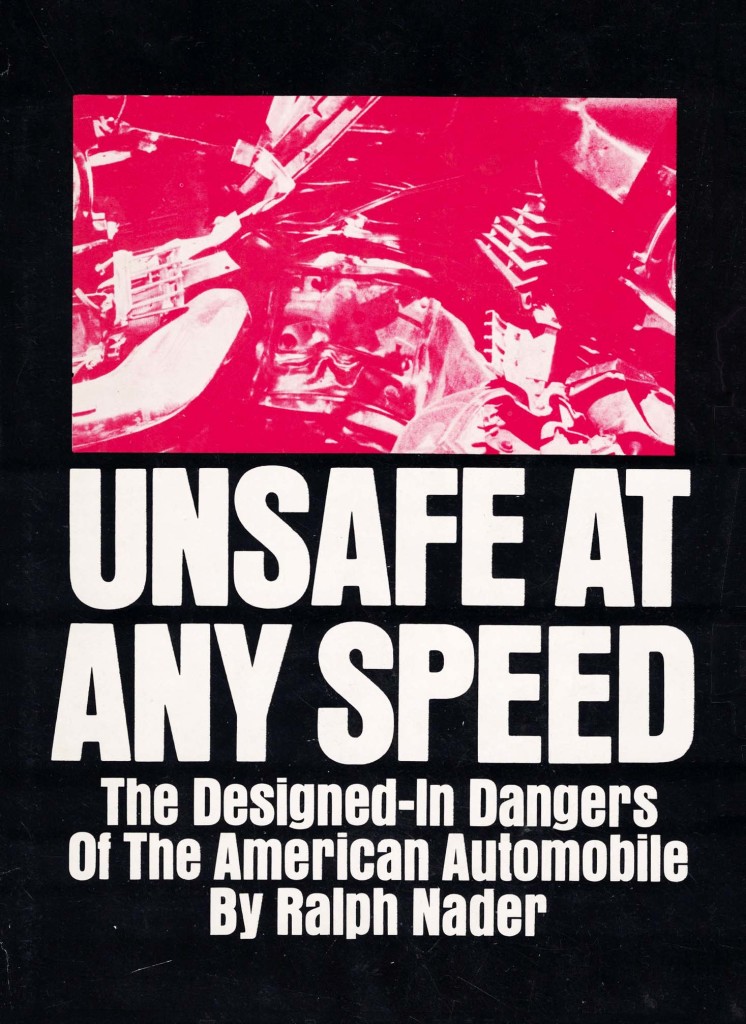Article by Paul Williams, photos from Grossman Publishers, General Motors, nader.org. Additional photos by Autos.ca staff.
Back in the early 1960s, Chevrolet introduced a vehicle called the Corvair. It featured novel design and unusual, by American standards, engineering. Like the old Volkswagen Beetle, the air-cooled engine was at the rear, where it also used a potentially troublesome swing-axle suspension (see descriptive link below). The comparatively compact-sized Corvair came in a range of body styles including convertible, coupe, sedan, station wagon and minivan.
It also, according to American consumer advocate Ralph Nader, featured a propensity for its rear wheels to “tuck in” when cornering that would cause the car to suddenly rotate without warning. Before some hapless Corvair drivers knew it, they were headed backwards down or off the road, with no chance of regaining control. And in the event of a frontal collision, according to Mr. Nader, the fixed steering column might finish the driver off by impaling him or her like a medieval knight at the end of a jousting lance.
Apparently many small aftermarket companies did a brisk business selling “fix kits” for the Corvair, and all the enthusiast car magazines of the day commented on the challenge of driving the Corvair safely.
As it turned out, Chevrolet was well aware of the Corvair’s tendency to “oversteer,” and to compensate recommended the expedient of setting the front tire pressure to 15 pounds per square inch (psi) with 26 psi at the rear. At one of the numerous court cases involving the Corvair, one tire specialist indicated that these pressures were “dangerous under any circumstances for any purposes.”
Chevrolet properly addressed the Corvair’s handling problems in a complete redesign for 1965, which coincidentally was also the year Ralph Nader released his famous book, Unsafe at Any Speed. The book not only targetted the Corvair (featured in Chapter 1, so it got lots of attention), but was a scathing indictment of the entire US automotive industry. He used terms like “slaughter” and “carnage” to drive home his points, and he was just as critical of Ford and Chrysler as he was of General Motors. To say that Mr. Nader and his book made waves would be an understatement.
The motivation for Mr. Nader’s book was the unrelenting and staggeringly high rate of motor vehicle deaths each year in the US. Typically, between 30,000-40,000 deaths were recorded annually from 1930 onwards, and in the year of Unsafe at Any Speed’s publication in November 1965, 47,089 people were killed in car crashes in the US. True, by then there were many more cars on the road than in the 1930s, and many more kilometers driven, but the number of deaths per 100,000 people continued to rise until 1972 and wouldn’t consistently decline until the 1990’s. This in addition to millions of automobile related injuries per year.
Nader’s position was that car companies were thoroughly disinterested in safety, choosing instead to focus on styling and marketing. He posited that the lack of safety was “built in” to cars by neglect; that their engineering was fundamentally unchanged since the 1920s, that numerous safety features could be fitted to or engineered into vehicles that would help protect occupants in a collision or a crash, but that it was more profitable for automobile manufacturers to support the position that the construction of cars had little or nothing to do with their safety. As a young lawyer with a social conscience and an interest in tort law, Mr. Nader found his calling.














